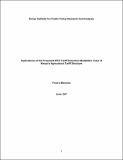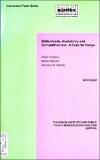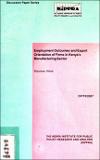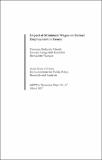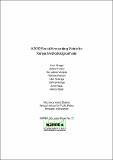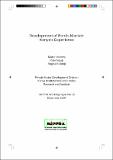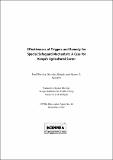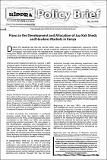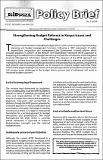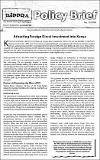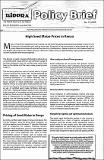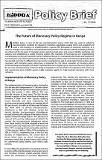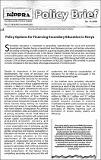3. KIPPRA Research Publications: Recent submissions
Now showing items 561-580 of 708
-
Discussion Paper No. 80 of 2007 on Implications of the Proposed WTO Tariff Reduction Modalities: Case of Kenya’s Agricultural Tariff Structure
(The Kenya Institute for Public Policy Research and Analysis (KIPPRA), 2007)Various proposals in the World Trade Organization agricultural market access negotiations are explained and their implication to tariff reduction in terms of meeting stated objects evaluated in reference to Kenya’s ... -
Discussion Paper No. 76 of 2007 on Private Sector Investment in Primary and Secondary Education in Kenya: Issues, Challenges and Recommendations
(The Kenya Institute for Public Policy Research and Analysis (KIPPRA), 2007)Although many governments are committed to implementing education goals, including Education for All (EFA) and Universal Primary Education (UPE), they are constrained by availability of resources. Private sector involvement ... -
Discussion Paper No. 70 of 2007 on Skills Needs, Availability and Competitiveness: A Case for Kenya
(The Kenya Institute for Public Policy Research and Analysis, 2007)Kenya has put a lot of emphasis on human capital development as a way of facilitating economic growth. The link between human capital (skills) and growth is through high productivity and improved competitiveness. This ... -
Discussion Paper No. 68 of 2007 on Policy and Institutional Interventions to Revitalize Kenya's Pyrethrum Industry
(The Kenya Institute for Public Policy Research and Analysis (KIPPRA), 2007)Kenya has been the leading global pyrethrum producer for over four decades. The sub-sector has made significant contribution to economic growth through employment generation, foreign exchange earnings and livelihood ... -
Discussion Paper No. 78 of 2007 on Employment Outcomes and Export Orientation of Firms in Kenya's Manufacturing Sector
(The Kenya Institute for Public Policy Research and Analysis, 2007)Kenya's manufacturing sector accounts for over 10 per cent of GDP. Intensification of trade liberalization reforms in the 1990s saw the share of exporting firms increase. This seems to have coincided with a rise in use of ... -
Discussion Paper No. 73 of 2007 on Microstructure Elements of the Bonds Market in Kenya
(The Kenya Institute for Public Policy Research and Analysis (KIPPRA), 2007)The importance of market microstructure in determining the success of a bonds market in allocating financial resources depends on the degree to which the microstructure elements have been designed to determine the proper ... -
Discussion Paper No. 67 of 2007 on Impact of Minimum Wages on Formal Employment in Kenya
(The Kenya Institute for Public Policy Research and Analysis (KIPPRA), 2007)This paper uses time series data to analyze the impact of minimum wages on employment in the private and public formal sectors in Kenya. An error correction model is used to analyse the long-run and short-run effect of ... -
Discussion Paper No. 72 of 2007 on a 2003 Social Accounting Matrix for Kenya: Methodological Note
(The Kenya Institute for Public Policy Research and Analysis (KIPPRA), 2007)A Social Accounting Matrix (SAM) is a consistent data framework that captures information contained in the national income and product accounts and the input-output table, as well as the monetary flows between institutions. ... -
Working Paper No. 15 of 2007 on Development of Bonds Market: Kenya's Experience
(The Kenya Institute for Public Policy Research and Analysis (KIPPRA), 2007)Development of bonds market widens the financing options for firms and enables the government to shift its domestic debt to longer-term securities. However, development of bonds market requires that certain conditions ... -
Discussion Paper No. 66 of 2007 on Special Products Under WTO Negotiations: The Case for Kenya
(The Kenya Institute for Public Policy Research and Analysis (KIPPRA), 2007)There is need to identify agricultural products that may be designated as Special Products (SPs) for the purpose of receiving Special and Differential Treatment (SDT) under World Trade Organization (WTO) provisions. Special ... -
Discussion Paper No. 69 of 2007 on Effectiveness of Triggers and Remedy for Special Safeguard Mechanism: A Case for Kenya's Agricultural Sector
(The Kenya Institute for Public Policy Research and Analysis (KIPPRA), 2007)This paper provides an analysis of the effectiveness of the proposed reference price and volume triggers in the on going WTO negotiations on “Special Safeguard Mechanism” (SSM). The SSM is to be used by developing countries ... -
Discussion Paper No. 81 of 2007 on Impact of Primary School Education Inputs and Outputs in Kenya: Empirical Evidence
(The Kenya Institute for Public Policy Research and Analysis (KIPPRA), 2007)This paper examines a range of factors that determine primary school output (proxied by examination performance) with an aim of identifying the main inputs that are of policy relevance in the improvement of quality of ... -
Policy Brief No. 06 of 2006 on Flaws in the Development and Allocation of Jua Kali Sheds and Hawkers Markets in Kenya
(The Kenya Institute for Public Policy Research and Analysis, 2006)Despite the beneficial role that the Jua Kali sector' plays in providing employment, improving income distribution, and developing dynamic private enterprises, initiatives to support its growth by providing workspaces ... -
Policy Brief No. 09 of 2006 on Using Social Budgeting to Improve the Budgetary Process in Kenya
(The Kenya Institute for Public Policy Research and Analysis, 2006)For a long time in Kenya, the budget has focused more on achieving macroeconomic targets . Despite being participatory in design, the Medium Term Expenditure Framework (MTEF) approach implemented since the year 2000 is ... -
Policy Brief No. 07 of 2006 on Strengthening Budget Reforms in Kenya: Issues and Challenges
(The Kenya Institute for Public Policy Research and Analysis, 2006)The Government has been undertaking budget reforms with a view to improving fiscal policy, planning and budget management functions. Following a 1997 assessment of public expenditure composition and management, the ... -
Policy Brief No. 15 of 2006 on Attractig Foreign Direct Investment into Kenya
(The Kenya Institute for Public Policy Research and Analysis, 2006)Kenya has witnessed a decline in net flows of foreign direct investment (FDI) in the last two decades. A significant decline occured in the 1990s when the economy was going through various policy and institutional ... -
Policy Brief No. 13 of 2006 on High Maize Prices in Kenya
(The Kenya Institute for Public Policy Research and Analysis, 2006)Maize is the primary staple food crop in Kenya. It is the most frequently produced and marketed crop,grown by 90 percent of households and sold by more than 30 percent of the households in areas where the crop is grown. ... -
Policy Brief No. 17 of 2006 on the Future of Monetary Policy Regime in Kenya
(The Kenya Institute for Public Policy Research and Analysis, 2006)Monetary policy is one of the key macroeconomic policy tools that are used to influence macroeconomic variables by regulating monetary aggregates and/or terms and availability of credit in the economy. Its implementation ... -
Policy Brief No. 14 of 2006 on Policy Options for Financing Secondary Education in Kenya
(The Kenya Institute for Public Policy Research and Analysis, 2006)Secondary education is important in generating opportunities for social and economic development. Besides being a transitional level between primary and tertiary education, secondary schooling provides a base for acquiring ... -
Policy Brief No. 16 of 2006 on Strengthening the Regulatory Framework for Private Healthcare Providers in Kenya
(The Kenya Institute for Public Policy Research and Analysis, 2006)Private healthcare provision has grown from a few providers at independence to about 2,640 by 2004.This growth can be traced in two periods. The first was the 1970s when the government allowed civil servants to engage in ...

